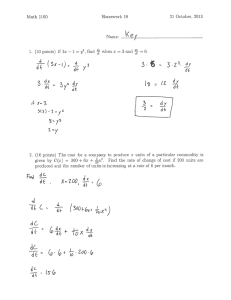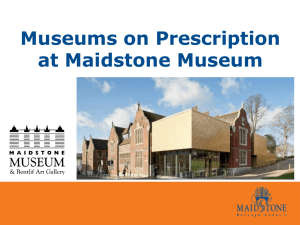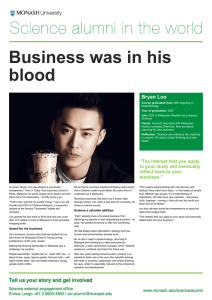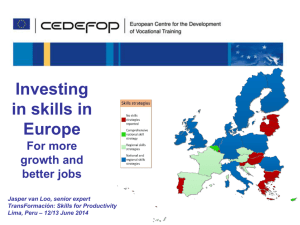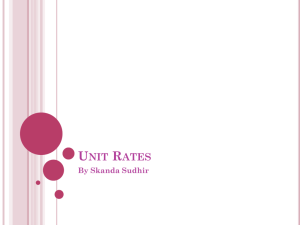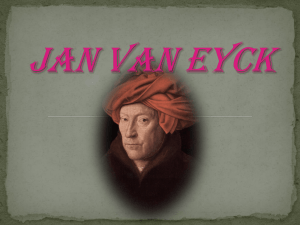Alison Manley UGA Research Award Essay
advertisement
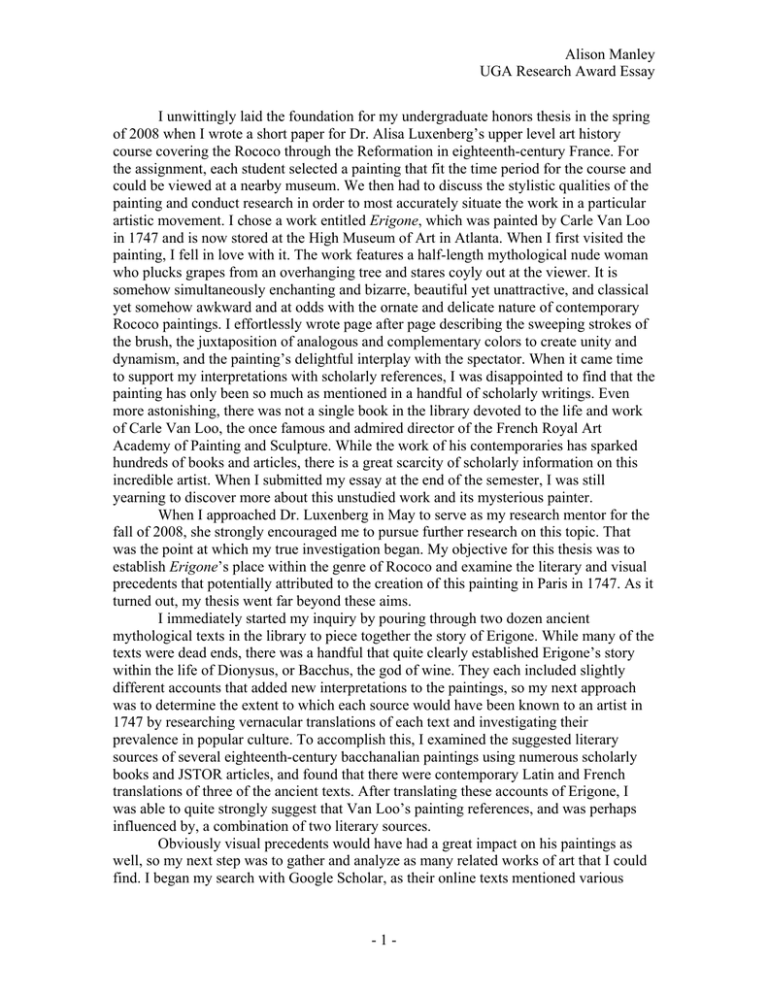
Alison Manley UGA Research Award Essay I unwittingly laid the foundation for my undergraduate honors thesis in the spring of 2008 when I wrote a short paper for Dr. Alisa Luxenberg’s upper level art history course covering the Rococo through the Reformation in eighteenth-century France. For the assignment, each student selected a painting that fit the time period for the course and could be viewed at a nearby museum. We then had to discuss the stylistic qualities of the painting and conduct research in order to most accurately situate the work in a particular artistic movement. I chose a work entitled Erigone, which was painted by Carle Van Loo in 1747 and is now stored at the High Museum of Art in Atlanta. When I first visited the painting, I fell in love with it. The work features a half-length mythological nude woman who plucks grapes from an overhanging tree and stares coyly out at the viewer. It is somehow simultaneously enchanting and bizarre, beautiful yet unattractive, and classical yet somehow awkward and at odds with the ornate and delicate nature of contemporary Rococo paintings. I effortlessly wrote page after page describing the sweeping strokes of the brush, the juxtaposition of analogous and complementary colors to create unity and dynamism, and the painting’s delightful interplay with the spectator. When it came time to support my interpretations with scholarly references, I was disappointed to find that the painting has only been so much as mentioned in a handful of scholarly writings. Even more astonishing, there was not a single book in the library devoted to the life and work of Carle Van Loo, the once famous and admired director of the French Royal Art Academy of Painting and Sculpture. While the work of his contemporaries has sparked hundreds of books and articles, there is a great scarcity of scholarly information on this incredible artist. When I submitted my essay at the end of the semester, I was still yearning to discover more about this unstudied work and its mysterious painter. When I approached Dr. Luxenberg in May to serve as my research mentor for the fall of 2008, she strongly encouraged me to pursue further research on this topic. That was the point at which my true investigation began. My objective for this thesis was to establish Erigone’s place within the genre of Rococo and examine the literary and visual precedents that potentially attributed to the creation of this painting in Paris in 1747. As it turned out, my thesis went far beyond these aims. I immediately started my inquiry by pouring through two dozen ancient mythological texts in the library to piece together the story of Erigone. While many of the texts were dead ends, there was a handful that quite clearly established Erigone’s story within the life of Dionysus, or Bacchus, the god of wine. They each included slightly different accounts that added new interpretations to the paintings, so my next approach was to determine the extent to which each source would have been known to an artist in 1747 by researching vernacular translations of each text and investigating their prevalence in popular culture. To accomplish this, I examined the suggested literary sources of several eighteenth-century bacchanalian paintings using numerous scholarly books and JSTOR articles, and found that there were contemporary Latin and French translations of three of the ancient texts. After translating these accounts of Erigone, I was able to quite strongly suggest that Van Loo’s painting references, and was perhaps influenced by, a combination of two literary sources. Obviously visual precedents would have had a great impact on his paintings as well, so my next step was to gather and analyze as many related works of art that I could find. I began my search with Google Scholar, as their online texts mentioned various -1- Alison Manley UGA Research Award Essay images of Erigone and included footnotes which led me to more sources that discussed bacchanalian paintings. JSTOR proved to be useful in this search for the same reasons. Though this approach led to innumerable dead ends, I also looked through nearly every book in the library that dealt with Early Modern European art. In the end and after an exhaustive search, I found less than a dozen works that referenced the mythological maiden, including a French tapestry, engravings, woodcuts, paintings, and sculptures. I was reluctant to put my research on hold when I moved to London for three months over the summer to work at a museum, so I continued my research in my spare time, utilizing the plethora of sources London had to offer. I went to nearly every museum in London at least once to examine the paintings for references to Erigone, and on multiple occasions I was able to set appointments with directors and scholars at the museums to utilize their knowledge of eighteenth-century art and ask for research suggestions. I was also incredibly excited to be able to personally examine one of Van Loo’s contemporary’s painting of Bacchus and Erigone, one of my visual precedents of 1745, at the Wallace Collection. So between the High and the Wallace Collection I was lucky enough to be able to work with two amazing primary sources. The museum in which I worked, Guildhall Art Gallery, houses the city of London’s collection of paintings and also has an extensive library from which I was able to conduct research. As the museum focused on writings pertaining to British history, I looked for British artistic and historical references to the theme of Erigone, but there was little information that truly added to an understanding of Van Loo’s work. My research was more successful, however, at the British Library, where I spent every Thursday and Friday conducting research for an exhibition at the Guildhall and my thesis. It was there that I generated perhaps one of my more innovative ideas concerning Van Loo’s method of painting, as highlighted in Erigone. Throughout my research I was constantly intrigued by the face of the figure in the painting, so on a whim I began to research Van Loo’s use of models and the use of models amongst his contemporaries. Family members were often popular models in the eighteenth century, but I had originally disregarded this notion in Van Loo’s case because his figures were so often generalized. After days of scouring the British Library’s texts and examining online journals like the Grove Dictionary of Art, Art Encyclopedia, and JSTOR, I found a painting by Van Loo’s close cousin and fellow painter, Charles-Amedée Van Loo, of Charles’s wife and two sons in 1764. The unique features of the wife’s face bore a remarkable resemblance to those of Van Loo’s figure of Erigone, which led me on a new search to attempt to support the idea of this woman as Van Loo’s model. In simply comparing the features of the women in each painting, which is not entirely reliable as the images were undoubtedly influenced by each artists’ subjectivity or tendency to idealize, I argued that the works could certainly support the idea of one model, as the seventeen year difference in time seems to correlate to a progression in age of the woman. My most compelling evidence for this suggestion was found after I spent two days reading through Parisian churches’ civil records at the British Library. The Hôtelde-Ville noted that Charles was married in 1747, the very year in which Erigone was painted. From there, I researched the idea of bacchanalian scenes commissioned in relation to marriages, and found a great many examples of contemporary commissions that would support a reading of this painting as a bridal gift. -2- Alison Manley UGA Research Award Essay When I returned to Athens, I used Interlibrary Loan to procure the one book that solely focuses on Carle Van Loo: Marie-Catherine Sahut’s catalogue that includes all of the extant paintings and drawings of Van Loo that were collected for an exhibition in Nice in 1977. After carefully examining the drawings of his wife and children, I was able to further support my assertion that Van Loo heavily relied on his family members as models by comparing these drawings to figures in many of his paintings. I was also able to use Sahut’s catalogue to successfully categorize Van Loo’s oeuvre within the realm of the Rococo. The marriage that took place in 1747 sparked my interest in the other events that may have influenced Van Loo in the same year. Colin B. Bailey’s The Loves of the Gods mentioned a competition within the French Royal Art Academy that was held in 1747, for which Van Loo painted a bacchanalian figure, Silenus. Upon further research in eighteenth-century texts, I found that two well-known artists, a painter and a sculptor, submitted works to the competition that showcased Erigone. I used the footnotes in Bailey’s text to investigate his reference to the popular Comèdians italiens, whom I discovered espoused the theme of Erigone in art at a well-attended Parisian show. At this point, certain that the theme of Erigone had appeared in a previous European play or production, I followed that direction to find, eventually thanks to Marvin A. Carlson’s book on eighteenth-century theater, that the great art critic Voltaire had overseen the stage production of a short play entitled Erigone, performed for the King and Queen, for whom Van Loo was the revered first painter, in January of 1747. The reference to Voltaire led me to investigate the critical reception of Van Loo’s work. As Erigone is not recorded to have been publicly displayed, I read the leading art critics’ Salon reviews of Van Loo’s submitted works throughout his life. Regarded among scholars as one of the few remaining ways to gauge public opinion in the absence of extant journals and before the burgeoning of the popular press, I had to analyze the reviews of these French critics with a grain of salt, keeping in mind their upper class, educated backgrounds, their different hidden agendas, and their known stylistic preferences. I also considered the common Parisian’s reaction to Erigone by using Gil to find books discussing sexuality and the predilection for the erotic in the visual culture of eighteenth-century France. At this point, I wanted to consider Van Loo’s reputation as a function of his patronage, so I contacted the High Museum and requested any information they had on the provenance for the painting. The museum practically had no scholarly information on the painting, so I had to use the minimal provenance listed in the High’s European art catalogue to more firmly suggest certain dates and patrons for the paintings throughout the second half of the eighteenth century. An engraving of Van Loo’s Erigone very faintly notes that the original painting by Van Loo hung in the “cabinet de M. de Peters, Peintre de S.A. Le Prince Charles, Gouverneur des Paybas.” Of course from this point I had to research French government of the eighteenth-century to establish the time during which this governor oversaw a constituency in the Netherlands, and at which point he employed the artist Johan Anton de Peters. I used these facts to determine a concise time period in which de Peters could have owned the work and the engraver could have seen it in his collection. I read through a German book about de Peters to determine the type of work he collected as a testament to Van Loo’s reputation. In order to most accurately suggest the time period during which de Peters owned the painting, I contacted the -3- Alison Manley UGA Research Award Essay Metropolitan Museum of Art and requested a copy of their records of Van Loo’s estate upon his death to determine whether the painting was still in his collection at that point. So in the end, I was able to quite accurately contribute dates to Erigone’s provenance. In the same vein of patronage, I researched and discussed possible reasons for the engraving of the painting. Given Voltaire’s apparent esteem for Van Loo in his Salon reviews, I argued that it’s possible the engraving was made to entice Catherine the Great of Russia, an avid art collector, to purchase the work from de Peters, given her close connection to both the engraver and Voltaire. Upon further research on the engraver in Google Scholar, the only source that returned results on the artist, I stumbled across a manuscript he wrote in the late eighteenth-century that promoted a return to antiquity and a focus on expression in art, both of which are featured in Erigone and could have contributed to his selection of the painting. All of these connections throughout the European art community were actually discovered as a result of curious whims, but I collected enough valid information from records of art collections and historical sources to support these suggestions to some degree. Given the scarcity of scholarly writing on Carle Van Loo, I could not be more proud of what my thesis has contributed to the understanding of his life and oeuvre. As he was an artist who was violently pushed into obscurity with the disparagement of the Rococo in the nineteenth century, my thesis proposes and supports a new interpretation of Van Loo, his influences, and his style. I have been asked to meet with Dr. David Brenneman, the chief curator of the High Museum, on February 27 to discuss the possibilities for this thesis, and I hope that as a result my research will make an impact on the study and appreciation of this great French artist. My research took place on two continents, in four major libraries, with the assistance of five different museums. My sources included French, German, and Latin primary and secondary texts, as well as multiple works of art as primary sources. There was almost no scholarly information on which to begin my investigation of Erigone and Van Loo, so the vast majority of my thesis is based on original research collected over the course of a year. This entire process has undoubtedly been the best method of preparation for my graduate studies in the fall, and I look forward to continuing my research on Van Loo and many other underrepresented artists in the future. -4- Bibliography Actes d’état-civil d’artistes français, peintres, graveurs, architectes, etc., extr. Des registres des l’Hôtel-de-Ville. Orléans : H. Herlusion, 1873. Bailey, Colin B. Patriotic Taste: Collecting Modern Art in Pre-Revolutionary Paris. New Haven: Yale University Press, 2002. Bailey, Colin B. The Loves of the Gods: Mythological Painting from Watteau to David. New York: Rizzoli International Publications, Inc., 1992. Bailey, Colin B., Philip Conisbee, and Thomas W. Gaehtgens. The Age of Watteau, Chardin, and Fragonard. New Haven: Yale University Press, 2003. Blanc, Charles, and Adolphe Narcisse Thibaudeau. Le trésor de la curiosité. Paris: Vve J. Renouard, 1857. Bryan, Michael. Dictionary of Painters and Engravers, Biographical and Critical. London: George Bell and Sons, 1889. Bull, Malcolm. “Poussin and Nonnos.” The Burlington Magazine vol. 140, no. 1148 (November 1998): 724-738. Carlson, Marvin A. Voltaire and the Theatre of the Eighteenth Century. Westport, Connecticut: Greenwood Publishing Group, 1998. Goodman, John. Diderot on Art : The Salon of 1765 and Notes on Painting (Vol. 1). New Haven: Yale University Press, 1995. Hopkinson, N. “Review: The Erigone of Eratosthenes.” The Classical Review vol. 47, no. 1 (1997): 29-31. Johann Anton de Peters: Ein Kölner Maler des 18. Jahrhunderts in Paris. Köln: WallrafRichartz-Museum, 1981. - 41 - La Font de Saint-Yenne. Sentimens sur quelques ouvrages de peinture, sculpture et gravure. Genève: Slatkine Reprints, 1970. Le Normand d’Étoiles, Jeanne Antoinette, and Hugh Noel Williams. Madame de Pompadour. New York: C. Scribner’s Sons, 1902. Levey, Michael. Painting and Sculpture in France 1700-1789. New Haven: Yale University Press, 1995. Lyne, Raphaele. Ovid’s Changing Worlds: English Metamorphoses, 1567-1632. Oxford: Oxford University Press, 2001. Mollet, John William. Watteau. London: Sampson Low, Marston, Searle & Rivington, 1883. Moore, Thomas. The Odes of Anacreon. London: Gibbings & Company. 1800. Panofsky, Erwin. “A Mythological Painting by Poussin.” The Burlington Magazine (1961): 318-321. Pepper, D. Stephen. “Guido Reni’s ‘Erigone’: A Work Restored and a Mystery Resolved.” The Burlington Magazine (1986): 206-209. Poe, George. The Rococo and Eighteenth-Century French Literature: A Study through Marivaux’s Theater. New York: Peter Lang, 1987. Rosenberg, Pierre. French Paintings: 1500-1825. San Francisco: The Fine Arts Museum of San Francisco, 1987. Rounding, Virgina. Catherine the Great: Love, Sex and Power. London: Hutchinson, 2006. Rouse, W. H. D. Nonnos Dionysiaca. Cambridge: Harvard University Press, 1940. - 42 - Sahut, Marie-Catherine. Carle Vanloo: Premier peintre du roi. Nice: Musée Chéret, 1977. Sheriff, Mary D. Moved by Love: Inspired Artists and Deviant Women in EighteenthCentury France. Chicago: The University of Chicago Press, 2004. Siegfried, Susan L. “Hybridity: Genre (Gender) and Portraiture.” Eighteenth Century Studies (Oct. 2008) < http://www.umich.edu/~ecsg/essays/Hybridity.htm>. Smith, R. Scott, and Stephen Trzaskoma. Apollodorus’ Library and Hyginus’ Fabulae: Two Handbooks of Greek Mythology. Indianapolis: Hackett Publishing, 2007. Thomas, Joseph. Universal Pronouncing Dictionary of Biography and Mythology. Philadelphia: J.B. Lippincott Company, 1908. Volle, Nathalie. Jean-Simon Berthélemy. Paris: Arthena, 1979. Klingsöhr-Leroy, Cathrin, Juan J. Luna, Shearer West, and Laurie G. Winters. (2008). “Carle Van Loo.” Grove Art Online. Retrieved October, 2008, from Oxford Art Online database. Worley, Michael Preston. Pierre Julien: Sculptor to Queen Marie-Antoinette. New York: iUniverse, 2003. Zafran, Eric M. European Art in the High Museum. Atlanta: High Museum of Art, 1984. Zafran, Eric M. The Rococo Age: French Masterpieces of the Eighteenth Century. Atlanta, High Museum of Art, 1983. - 43 - ABSTRACT ALISON MANLEY Erigone and Carle Van Loo (Under the Direction of DR. ALISA LUXENBERG) Carle Van Loo was an influential and successful artist of the eighteenth century who garnered the highest awards and attracted the most elite of patrons, yet, originally due to the disparagement of Rococo art with the rise of Neo-Classicism, there is an enduring scarcity of scholarship on Van Loo and his paintings. This thesis elucidates numerous aspects of Van Loo’s oeuvre through a thorough examination of Erigone, his 1747 bacchanalian painting housed in the High Museum of Art. This intriguing painting is an exemplar of the artist’s eclectic style, imbued with Rococo sexuality and influenced by Flemish art of the seventeenth century. The work was likely an amalgamation of various literary sources and visual precedents, which are explored in order to frame the scene within the mythology of the life and death of Erigone, a love of Bacchus. The amorous nature of the woman’s legend leads to a suggested model for the figure and prompts a discussion of the extent to which Van Loo’s female iconography was influenced by his family members. Finally, this thesis investigates the painting’s provenance and its known replications as indicators of the painting’s, and by extension Van Loo’s, contemporary esteem. In the end, this research is meant to negate Van Loo’s reputation within the history of art as solely representative of the frivolity and inanity associated with the Rococo. INDEX WORDS: Carle Van Loo, Carle Vanloo, Erigone, 18th Century, France, Art, 1747 Salon, Rococo
